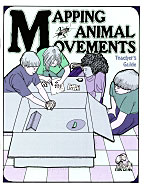Mapping Animal Movements
Grades 5—8
Written by Katharine Barrett
Learning about the patterns and habitat needs of animals in
the wild is key to conserving species and protecting our environment.
It's obviously impractical to undertake these studies around
the clock and in global proportions, but students of this unit
learn how scientists use sampling and mapping to quantify and
compare animal movements.
In Mapping Animal Movements, students apply such field
biology techniques to study the behavior and requirements of
hamsters and crickets. The students use careful observation,
plan and conduct experiments, and graph the changes in animal
movement patterns when food and shelter are added to a laboratory
environment.
There are special sections on animal care, food, housing, and
handling, and excellent resources and advice for obtaining animals
for the classroom. Real-world connections are introduced with
a description of mapping tule elk movements in California. In
an effort to advance humane and ethical treatment of animals
used in the classroom, the guide includes the NSTA Code of Practice
on Animals in School.
Several other GEMS guides geared for these grade levels, including
Mapping Fish Habitats, Animals
in Action, and Aquatic
Habitats, make natural connecting units in the study
of animal behavior, habitat, and conservation.
Time: Four 30- to 45-minute sessions.
Comment on this GEMS unit.
|

This title is out of print.
Ordering information
Literature Connections
What materials are needed to present this unit? See the full list. |

